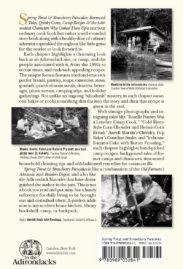Old Fashioned Recipes & Cures: Maybe there was some value to these old fashioned recipes and cures in the past, but I wouldn’t trust them.

Spring Trout and Strawberry Pancakes
Old Fashioned Recipes & Cures
An excerpt from ” Spring Trout and Strawberry Pancakes “, Starting on page 81.
ONE WEEKEND, as I was welding a go-devil, a wood splitting axe, at my Adirondack facsimile lean-to, I thought about all the labor it took to cut, split, stack, and dry wood for heating and cooking back in the day. I had thoughts too of the unusual-sounding old recipes I’d read in camp cook- books or heard mentioned. Certainly most dishes had been cooked on a wood-fired kitchen cookstove, although I know for a fact that Doc Latimer, Camp Seward’s renowned chef-owner, relied on a reflector oven, some- times known as a portable stove-top oven, to bake pies and cakes. He’d set it on top of the cast iron lids on Camp Seward’s boxstove, where it would reflect heat. Doc didn’t have a formal camp book of recipes. I learned about his cooking talents from his son, who was also a family physician. Probably because they were doctors, the men were also interested in cures that sound startling today. Who today would even think of putting a mixture of moss scraped from stones and simmered in cream in their mouth for a cold sore?
I would have had no idea what an attack of the ague was, or that wearing a piece of frankincense around one’s neck was the standard cure, except that a friend’s grandfather, Tom O’Donnell, mentioned it in his diary. He wrote about one incident when his friends had arrived to see him. “…I was in the midst of all this when relief came: my regular visitation of shaking ague. Old Pat took over the job of discouraging potato bugs. John Wilsey, who had never believed in so much as the existence of the disease, came in to see me in the grip of the ague, and by good chance at a time when I was putting on one of my more brilliant exhibitions. He looked on in silence at my performance. When the attack was over and the bed had ceased rattling, he said, ‘Gee but that was fun. Do it again, Tom!’”
“…John was asking what started the ague anyhow, and I told him potato bugs. Just one of my casual observations…”
Of course Tom was joking. The violent shakes were brought on by a fever. The cure? Mix one pound of blue vervain stalks and 4 ounces of boneset in with a gallon of good Irish whiskey. One teaspoon three times a day should bring the fever or ague under control.
Another cure out of the past was to wear finely pulverized rock salt be- tween the feet and the stockings for athlete’s foot. The remedy for worms was a teaspoon to a tablespoon of garlic dissolved in Irish whiskey and taken every morning. Wormwood tea or taking a bath in beef’s brine was recommended for rheumatism. A standard cure for the croup was equal quantities of mustard and salt mixed in a half glass of water, or even better, lard and molasses, skunk’s oil and alum in water! One-half pound of lean beef chopped fine added to one-half pint of rain water, a half teaspoon of salt and four drops of muriatic acid was supposed to be good for indigestion and diarrhea, but only after it stood for three hours. Then the clear liquid was taken after it was strained through a cloth. Here is an odd “Corrective for the Stomach:” a small piece of lime soaked in a quart of boiling water with a handful of raisins, with the dish kept covered while decomposition was taking place. A remedy for burns was a poultice made from soot taken from the inside of a stove pipe or chimney and one to three parts lard or fresh butter. This mixture was then spread on linen or muslin and applied to the burn.
The following is taken from an old Malone Cookbook loaned to Genevieve L. Wood by Mrs. Charles Anderson of Gouverneur. The date of publication is not known.
“Cure for Felon:5 Take equal parts of soft soap and best plug tobacco and simmer together. While hot bind on finger. It is frequently necessary for the patient to take a stimulant when this is applied.”
Our ancestors were hardy folk. They lived no life of ease,
But the cures they used for the ills they had
Were worse than the disease.
—From an unknown poet

The author, William Jay O’Hern, working up firewood.
Author’s Collection
Maybe there was some value to these cures in the past, but I wouldn’t trust them. And, no one reading them should. There are far safer corrective measures today. I would far rather sample some of the old recipes that have equally strange names, such as Glazed Currants and Graham Pudding.
The pudding was easy to make in camp: 1 cup of molasses, 1 cup of milk, 2 cups of graham [whole wheat] flour, 1 cup of raisins, 1 saltspoon6 of salt, 2 teaspoons of soda. Mix these ingredients and steam two hours.
Who today would look forward to a meal of fried cabbage? Its directions: “Chop fine a small cabbage. Put it in a frying skillet with water enough to cover and cook until tender. Then add 1 teaspoon of sweet cream, a piece of butter the size of an egg, pepper and salt. Fry till nearly dry. Serve hot.” I’d far rather look forward to some pickled cabbage, or better yet, pickled fish. Americans today have never chopped wood. Likewise, a good majority of folks might not be able to identify varieties of wood: beech, soft and hard maple, white and red oak, basswood, cherry, and locust, for instance. It all has to do with the needs and exposures of one’s life. I enjoy working up stacks of firewood. The very progress cheers me on. However, I’m glad I have never had to make bread from wood!
When I stayed at Camp Oasis, I learned from my grandparents how to split stove wood with a hatchet without cutting my fingers off. I must have been only six or seven years old. Later I learned the rudiments of how to maintain a wood-burning range. Watching Grandma cook on the cast iron stove-top range was a big thing. It took experience, skill and a bit of knack to boil something over one stove lid, simmer something over another, and keep something warm over still another, all at the same time and with the same fire.
Those cooking techniques have gone by the wayside for the most part. There are those little Everhot ovens that will bake a cake over a campfire.
An outdoor grill would work too, but why bother when the modern kitchen electric or gas oven is so much easier?
My wife and I still bake up some of our grandmothers’ tasty breads in our kitchen today. I’m always amazed by how fast a loaf of wholesome bread disappears. Bread-on-a-stick is about all I’ll bother cooking over an outdoor fire when camping. While the old cookbooks I’ve collected contain oodles of period recipes — Confederate Army Soup, Hickory Nut Pie, Green Corn Patties, Tomato Jam, Spruce Beer, and Parsnip Fritters — one of my favorites — it’s not the cooking lore that pulls my mind back to camp days gone by. It’s the tales that don’t stretch the blanket too far.

1946. Frank Skillman at Camp Seward. Doc Latimer’s Cold River camp was the site for many wilderness gourmet-style meals. Photographer C.V. Latimer, Sr., M.D.
Courtesy C.V. Latimer Jr., M.D.

